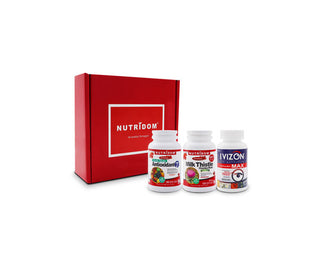1. Nutridom Antioxidant 7
Antioxidant Network
The term 'Antioxidant Network' was first coined by Dr. Lester Packer, PhD of UC Berkeley, regarded as the foremost antioxidant research scientist. Antioxidants are used up and turned into different but weak form of free radicals itself, while they scavenge free radicals in our bodies. Network antioxidants recycle one another, greatly enhancing their fighting ability and making the network greater than the sum of its parts.
5 Core Network Antioxidants
There are two types of antioxidant required in our bodies. While the fat-soluble antioxidants, vitamin E and CoQ10, protect the cell membrane against cellular aging, the water-soluble antioxidants, vitamin C and Glutathione, guard the interior of a cell from free radicals. The following 5 network antioxidants work together as a virtual powerhouse recycling one another to combat free radicals.
Glutathione is a water-soluble antioxidant eliminating toxins in the liver. Even though glutathione is synthesized in our bodies, the rate of its production and absorption start declining with age. As people get easily exposed to environmental and chemical toxins nowadays, the significance of glutathione gets more emphasized.Alpha Lipoic Acid (ALA)ALA is the only network antioxidant that is both water- and fat-soluble, rescuing and reviving other network antioxidants whether inside the cells or the cell membrane. Glutathione gets absorbed more efficiently into the system when taken with ALA.CoQ10 (Coenzyme Q10) is a fat-soluble antioxidant producing energy and blocking the oxidation of fat cells.Vitamin E is a fat-soluble antioxidant extending the cell cycle and minimizing cellular damages during cell division and replication.Vitamin C is the most familiar water-soluble antioxidant with a switch over role from being an antioxidant to a pro-oxidant under pathological conditions. Vitamin C and E support each other's antioxidant function.
2 Supporting Components
Selenium is known as an essential mineral for the network antioxidants. Selenium is not an antioxidant itself, but it plays a supporting role in the synthesis of glutathione and the reduction-oxidation of vitamin C and E.Vitamin B complex is a hidden player in the antioxidant network. As vitamin B complex exhibits both antioxidant and pro-oxidant properties, it is involved in a wide range of antioxidant function such as preventing cell damages, prolonging the lifespan of damaged cells, and protecting our system from mutations.2. Nutridom Milk Thistle 250 mg 120 VcapsNutridom Milk Thistleuses pharmaceutical grade Milk Thistle seed extract from fresh European Milk Thistle plant, standardized to 80% Silymarin. Daily dose contains 400 mg Silymarin, and all our products are tested in the laboratory prior to production to ensure quality and safety. Effectiveness and safety of Nutridom Milk Thistle have been reviewed by Health Canada (NPN 80024649), and all products are made in GMP certified facility.
There are over 300 research studies on milk thistle use and benefits that back up its proven value in liver health today. Many of these studies were carried out in Europe where Milk Thistle is a prescribed medication in Europe. Also, Milk thistle is one of the herbs approved by the Commission E for its beneficial effects on liver-related diseases such as toxic liver damage, inflammatory liver disease, and cirrhosis.
LIVER HEALTH
Milk thistle protects the cells of the liver by blocking the entrance of harmful toxins and helping remove these toxins from liver cells. Silymarin makes milk thistle a powerful antioxidant which works to maintain health and energy by protecting the body from damage caused by free radicals and lipid peroxidation, which can injure health cells and tissues. Also, Milk Thistle stabilizes the liver cell membrane and stimulates protein synthesis while accelerating the process of regeneration in damaged liver tissue. Last, Milk Thistle optimizes the production of bile and therefore makes fat digestion and absorption easy on liver.
CHOLESTEROL LEVEL SUPPORT
A clinical research suggests that milk thistle, combined with traditional treatment, can improve diabetes. Other studies also have shown a decrease in blood sugar levels and an improvement in cholesterol in people with type 2 diabetes. This lowering LDL, "bad" cholesterol level, by milk thistle help decrease the chance of developing heart disease too.
Remember diabetes is a serious condition. Ask a primary health practitioner before taking any supplements, as milk thistle may interfere with diabetic medication.
3. Ivizon Max 500 mg 60 Vcaps
Ivizion MAXis an eye-care supplement with formulation recommended by National Eye Institution and Health Canada. It contains high amounts of 8 vitamins/minerals and 2 herb extracts that are traditionally used to maintain optimal eye condition.
Zinc and Vitamin C, and Eye Health
Zincplays an important role in eye health as it protects eyes from age-related macular degeneration. Zinc in the photoreceptor membranes of the retina plays a role in protein-to- protein interactions, essential for maintaining proper cell structure and function of the retina cells.
Vitamin Cis important to eye health because of its role in protecting the proteins of the lens from oxidation. It serves as an antioxidant in the retina, and promotes wound healing in the cornea. Vitamin C is involved in the synthesis and metabolism of collagen in the cornea. Also, it protects the lens and retina from oxidative stress, as an absorber of UV radiation in the cornea and the aqueous humor.
Flavonoids & Polyphenols in Vision and Eye Health
Dietary flavonoidsare a group of polyphenols that impart color to fruits and vegetables. As they are involved in UV filtration in plants, they protect human eyes against oxidative stress and disease. For example, the retina is the most metabolically active tissue in the body, and hence has a high oxygen demand and vulnerability to oxidative stress. Flavonoids scavenge free radicals (oxidative stress), inhibit nitric oxide production (main component that damages cell) and inhibit other chemical pathways that result in other oxidative stresses.
Antioxidants (Vitamins, Lutein and Zeaxanthin) and Age-Related Macular Degeneration
Currently, one in five people over the age of 65 is living with age-related macular degeneration (Macular Degeneration Partnership, 2015). Adults with advanced macular degeneration have a markedly reduced quality of life and need for assistance with the activities of daily living.
In general, dietary modification and antioxidant nutritional supplementation show promise as approaches to the prevention of visual loss from age-related macular degeneration. Vitamins and minerals with antioxidant protection such as carotenoids, Vitamin E, zinc, Vitamin A, and Vitamin Care beneficial for delaying the aging process. However, high concentrations of lutein and zeaxanthin are the most effective potential antioxidants as they inhibit lipid peroxidation (a part of the aging process) in the eyes.

